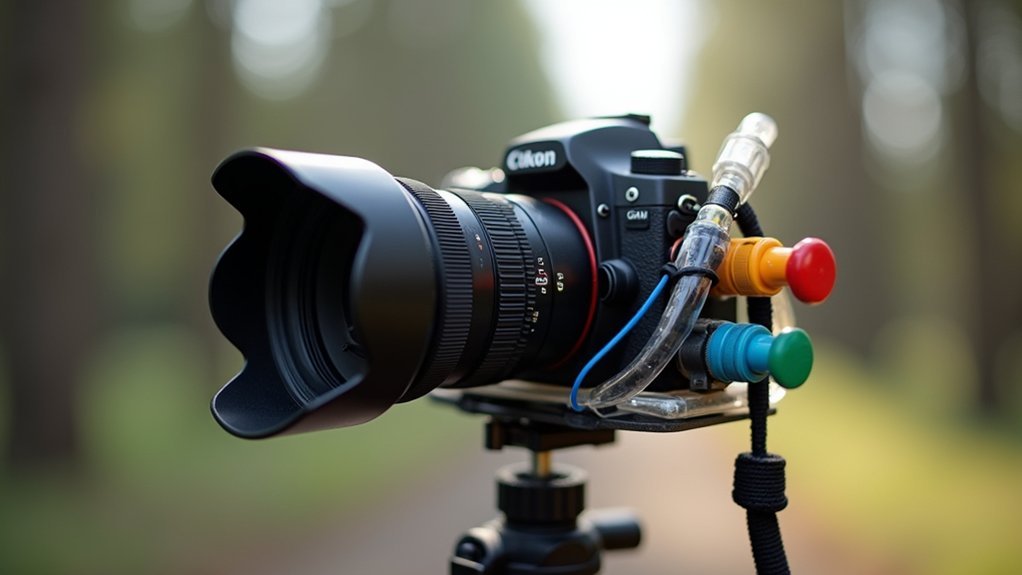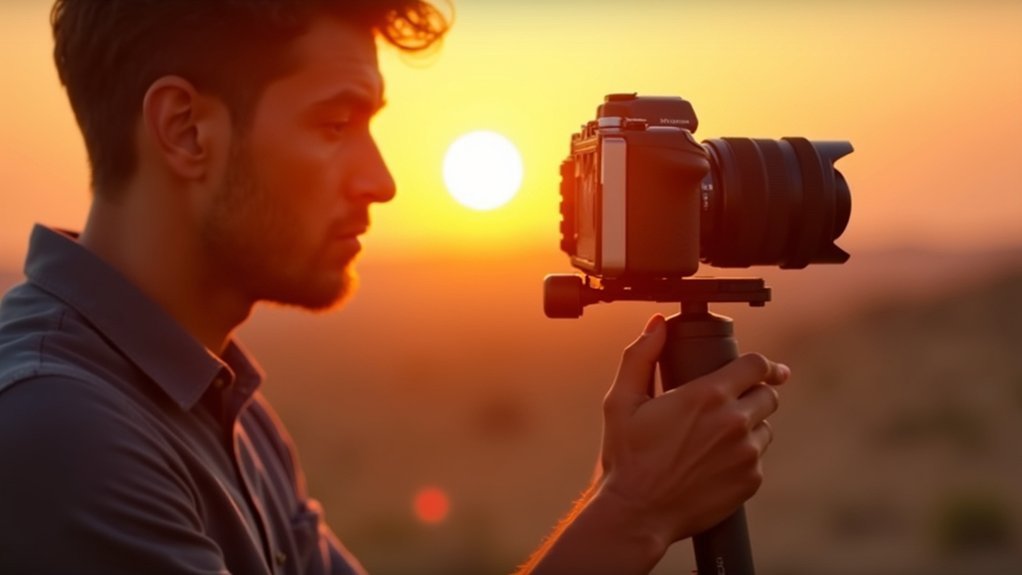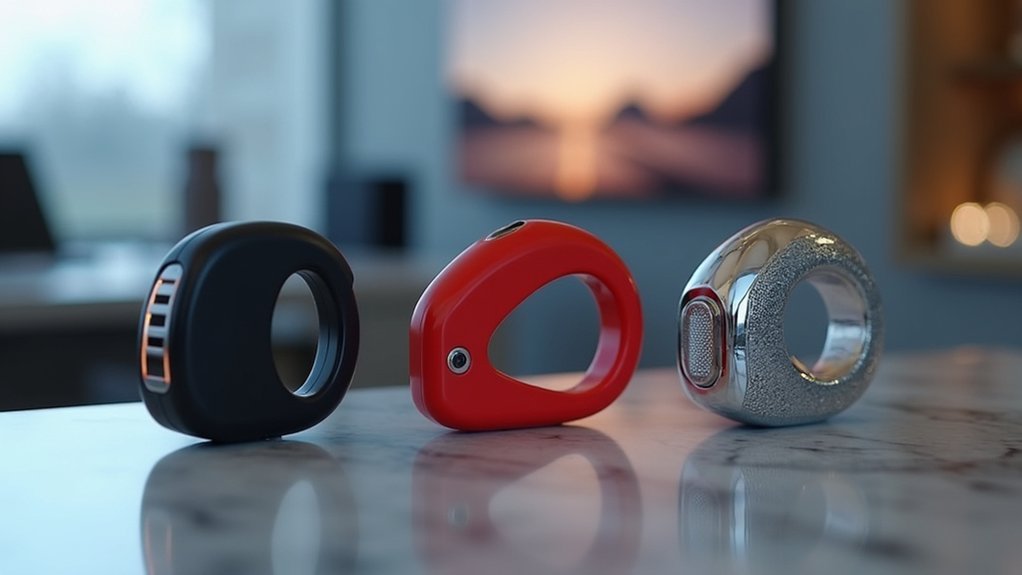The three best mouth-controlled camera triggers include DIY air-puff systems that respond to gentle breaths, MIOPS Smart Triggers with custom breath sensor attachments via the 3.5mm jack, and voice-activated controls that detect vocal commands for shutter activation. Each option offers hands-free photography for those with limited mobility, with varying levels of customization and sensitivity adjustment. These adaptive solutions provide both accessibility and creative potential for photographers seeking alternative ways to capture perfect moments.
Custom DIY Air-Puff Triggers for Adaptive Photography

Breathing new life into photography accessibility, custom DIY air-puff triggers empower photographers with limited mobility to capture stunning images without traditional hand controls.
These innovative solutions detect gentle breaths or puffs of air, translating them into camera activation.
You’ll need basic components like air sensors, microcontrollers (Arduino works well), transistors, and appropriate wiring.
When designing your trigger, focus on reliable mechanisms that safely short your camera’s trigger wires without damaging equipment.
The beauty of DIY approaches lies in their adaptability—you can customize sensitivity, response time, and ergonomics to match your specific needs.
They’re also budget-friendly compared to commercial alternatives.
Beyond accessibility benefits, these triggers open creative possibilities for wildlife photography (where silence matters) and can serve as engaging educational projects that blend electronics with photography skills.
Similar to the Panasonic Lumix setup, you’ll need to ensure your camera receives external power source to function properly with your custom trigger.
MIOPS Smart Trigger With Breath Sensor Attachment
The MIOPS Smart Trigger represents a versatile foundation for photographers seeking alternative control methods, though it doesn’t include built-in breath sensor capabilities.
The MIOPS Smart Trigger offers versatile control options for photographers while lacking native breath sensing functionality.
This powerful tool offers multiple triggering modes including Lightning, Sound, and Laser, but adapting it for breath control requires some creativity.
You can leverage the DIY mode through its 3.5mm jack to connect a custom breath sensor, as long as the sensor outputs between 0-3 volts.
When designing your setup, you’ll need to fine-tune both sensitivity thresholds and delay settings to achieve reliable breath-triggered operation.
While not officially documented for breath control compatibility, the MIOPS Smart Trigger’s customizable parameters make it a promising platform for adaptive photography solutions.
The combination of smartphone control via Bluetooth and its versatile triggering options provides a solid foundation for your mouth-controlled photography experiments. The trigger’s rechargeable battery offers up to 96 hours of continuous operation, making it ideal for extended photo sessions.
Voice-Activated Camera Controls as Mouth-Controlled Alternatives

While traditional assistive technologies focus on hands-free operation, voice-activated camera controls offer photographers with physical limitations a practical mouth-controlled alternative.
These systems use sensitive microphones that detect vocal commands to trigger your camera’s shutter.
You’ll find both ready-made options and DIY kits available, with adjustable gain controls to filter out ambient noise. The key advantage is precise timing—especially valuable for high-speed photography like capturing balloon pops or paint splashes. Working in a darkened room environment significantly improves trigger accuracy when capturing these fast-moving subjects.
Most units connect via headphone jacks, with self-contained models offering greater portability.
When selecting a voice trigger, consider the adjustable delay functions that let you fine-tune shutter release timing after sound detection.
Remember that environmental noise can cause false triggers, so you’ll need to optimize microphone placement and sensitivity settings.
Frequently Asked Questions
How Long Do Mouth-Controlled Trigger Batteries Typically Last?
Mouth-controlled camera trigger batteries typically last 6-13 hours of active use. You’ll get longer life with gesture-triggered algorithms that only activate when needed, extending battery performance by at least 31.5% over continuous operation.
Are Mouth-Controlled Triggers Water-Resistant for Outdoor Photography?
Most mouth-controlled triggers aren’t inherently water-resistant, but you’ll find some models with IP67 ratings available. You can also look for custom solutions that use waterproof materials like silicone for outdoor shooting conditions.
Can Mouth-Controlled Triggers Work With Vintage Film Cameras?
Yes, you can use mouth-controlled triggers with vintage film cameras if you have the right adapters. Most work through cable release ports, PC sockets, or hotshoe connections, though you’ll need specific adapters for certain models.
What Maintenance Is Required for Hygiene With Mouth-Controlled Devices?
You’ll need to use alcohol wipes for cleaning, apply disposable barrier sleeves with each use, avoid excessive lens wiping, and never submerge the device. Store in clean environments and follow manufacturer-specific disinfection protocols.
Do Mouth-Controlled Triggers Work in Extreme Temperature Conditions?
Mouth-controlled triggers may struggle in extreme temperatures. You’ll find their electronic components and materials can be affected by cold or heat, potentially reducing accuracy. Consider models with protective coatings for better environmental resilience.
In Summary
You’ve now got three excellent options for hands-free photography through mouth control. Whether you’re building your own air-puff system, investing in the MIOPS Smart Trigger with breath sensor, or using voice commands, you’ll find a solution that fits your needs and budget. Don’t let physical limitations stop your photography passion—these triggers will help you capture perfect shots while maintaining your creative independence and artistic vision.





Leave a Reply